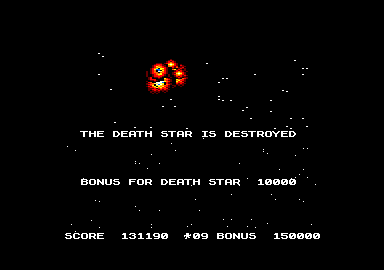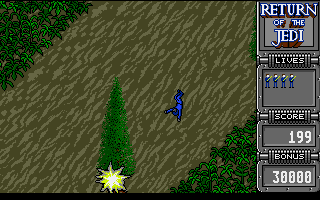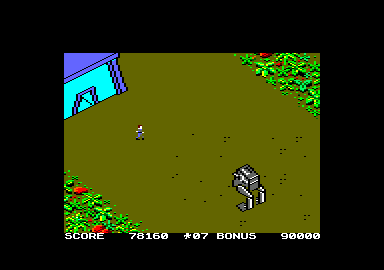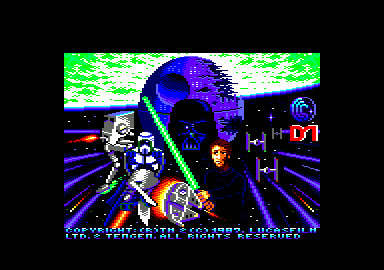Retro Replay Review
Gameplay
Star Wars: Return of the Jedi on Atari’s arcade system breaks the climactic third film into three distinct action sequences, each with its own pacing and challenge. The opening stage puts you in control of Princess Leia flying a speeder bike through the forests of Endor. As you weave between towering trees, you can shoot at Imperial troopers or cleverly lure them into Ewok traps. This mix of fast reflexes and tactical shooting gives the first stage a pulse-pounding urgency that feels rooted in the movie’s spirit.
(HEY YOU!! We hope you enjoy! We try not to run ads. So basically, this is a very expensive hobby running this site. Please consider joining us for updates, forums, and more. Network w/ us to make some cash or friends while retro gaming, and you can win some free retro games for posting. Okay, carry on 👍)
The second sequence switches to Chewbacca commandeering an AT-ST walker, offering a heftier, stomping feel to the gameplay. You’re dodging tripwire traps, blasting enemy walkers, and occasionally switching perspective to pilot the Millennium Falcon through a gauntlet of Star Destroyers and TIE fighters. These perspective changes keep the action fresh and test your ability to adapt instantly from ground combat to space dogfights.
In the final leg, you pilot the Millennium Falcon into the Death Star’s interior. Surviving waves of TIE fighters and laser turrets as you race toward the reactor adds a layer of claustrophobic tension. Once you blow the reactor, a frantic escape sequence begins, forcing you to retrace your steps before the station explodes. When you succeed, the game loops back to the speeder bike chase—now with tighter corridors and faster enemies—ensuring that veteran players will find a steep difficulty curve that rewards memorization and reflex sharpening.
Graphics
For an arcade title released in the mid-’80s, Return of the Jedi delivers surprisingly crisp, colorful sprites. The Endor forest stage uses rich greens and browns to evoke a woodland atmosphere, while the speeder and troopers remain clearly defined against the scrolling backdrop. Tree branches and stumps appear as hazards with just enough visual clarity to give players time to react.
The AT-ST walker sequence introduces chunkier, mechanical designs that contrast nicely with the forest setting. Enemy walkers sport bold outlines that make their movement patterns readable, and the perspective shift into the Falcon’s cockpit adds a satisfying sense of scale. The space dogfight segment, though rendered with simple starfields and blocky starships, still conveys a sense of vertical and horizontal motion that challenges players to track incoming fire.
The Death Star interior is rendered in stark, high-contrast grays and reds, creating a foreboding environment that matches the urgency of the reactor mission. The laser turrets and TIE fighters pop against the corridor walls, ensuring that threats are visible even at high speed. While pixelated by modern standards, the overall visual design remains coherent and serviceable, proving that solid artistry can shine through hardware limitations.
Story
Though the arcade adaptation omits lengthy cutscenes or dialogue, it remains faithful to the core beats of Return of the Jedi. Each stage captures a pivotal moment from the film: liberating Endor, battling Imperial walkers, and facing the Death Star’s destruction. This condensation of narrative into gameplay challenges keeps the pace brisk and taps into fans’ existing knowledge of the characters and plot.
The game’s attract mode and brief interstage animations provide just enough context to remind players where they are in the story, without slowing down the action. Icons like Princess Leia’s speeder silhouette or Chewbacca’s roaring AT-ST walker outline are instantly recognizable, drawing on the film’s visual shorthand to maintain immersion. Even newcomers can pick up the basic storyline: fight on Endor, storm the Death Star, and save the galaxy.
By merging narrative touchpoints with progressively tougher gameplay, the title honors the film’s triumphs while forging its own identity. The lack of text-heavy exposition means you spend more time playing and less time watching, which suits an arcade setting where seconds count and excitement never lets up.
Overall Experience
Star Wars: Return of the Jedi offers an adrenaline-fueled arcade experience that captures the final battle’s excitement in bite-sized segments. Its three-stage structure provides variety—jungle, land battle, and space infiltration—ensuring you’re rarely doing the same thing twice. Each stage feels distinct yet thematically tied to the film, making the game feel like a miniature action montage that you control.
Controls are responsive and intuitive: a joystick for movement, one button for firing, and in the case of the speeder bike, a single button for boosting speed. This simplicity lowers the barrier to entry, letting even casual players jump in and enjoy the action from the first coin drop. Veterans will appreciate the escalating difficulty and subtle pattern memorization required to reach the Death Star’s reactor, while newcomers can still savor the rush of each victory.
While modern gamers might find its graphics rudimentary and its high‐score chase loop somewhat repetitive, Return of the Jedi remains an arcade classic that perfectly distills the thrill of its source material. Its blend of fast reflex challenges, iconic settings, and faithful Star Wars fan service makes it a must-try for collectors and fans of retro arcade shooters alike.
 Retro Replay Retro Replay gaming reviews, news, emulation, geek stuff and more!
Retro Replay Retro Replay gaming reviews, news, emulation, geek stuff and more!









Reviews
There are no reviews yet.